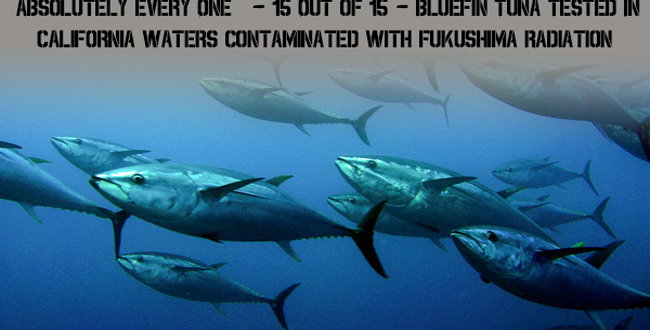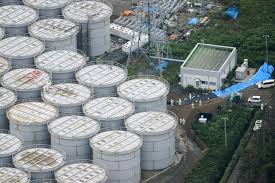Fukushima - The Never Ending Disaster
October 29, 2013
 (Left, Radiation in the water spreading out from Fukushima. Previous pic showing tsunamis was in error. Sorry. )
(Left, Radiation in the water spreading out from Fukushima. Previous pic showing tsunamis was in error. Sorry. ) After two and a half years, the Japanese still have not contained the fallout from Fukushima. It has morphed into a lethal threat to planetary life which clearly requires a global response. Instead, the Western media and our "leaders" have been largely silent. This article explains that the danger is actually three-fold, not including Japanese incompetence and corruption.
By Kevin Zeese and Margaret Flowers
Fukushima - A Global Threat That Requires a Global Response
(abridged/edited by henrymakow.com)
The story of Fukushima should be on the front pages of every newspaper. Instead, it is rarely mentioned. The problems at Fukushima are unprecedented in human experience and involve a high risk of radiation events larger than any that the global community has ever experienced. It is going to take the best engineering minds in the world to solve these problems and to diminish their global impact.
When we researched the realities of Fukushima in preparation for this article, words like apocalyptic, cataclysmic and Earth-threatening came to mind. But, when we say such things, people react as if we were the chicken screaming "the sky is falling."
Missing reactor cores: Since the accident at Fukushima on March 11, 2011, three reactor cores have gone missing. There was an unprecedented three reactor 'melt-down.' These melted cores, called corium lavas, are thought to have passed through the basements of reactor buildings 1, 2 and 3, and to be somewhere in the ground underneath.
The concern is that the corium lavas will enter or may have already entered the aquifer below the plant. That would contaminate a much larger area with radioactive elements. Some suggest that it would require the area surrounding Tokyo, 40 million people, to be evacuated. Another concern is that if the corium lavas enter the aquifer, they could create a "super-heated pressurized steam reaction beneath a layer of caprock causing a major 'hydrovolcanic' explosion."
A further concern is that a large reserve of groundwater which is coming in contact with the corium lavas is migrating towards the ocean at the rate of four meters per month. This could release greater amounts of radiation than were released in the early days of the disaster.
 Radioactive water leaking into the Pacific Ocean: TEPCO did not admit that leaks of radioactive water were occurring until July of this year. Shunichi Tanaka the head of Japan's Nuclear Regulation Authority finally told reporters this July that radioactive water has been leaking into the Pacific Ocean since the disaster hit over two years ago.
Radioactive water leaking into the Pacific Ocean: TEPCO did not admit that leaks of radioactive water were occurring until July of this year. Shunichi Tanaka the head of Japan's Nuclear Regulation Authority finally told reporters this July that radioactive water has been leaking into the Pacific Ocean since the disaster hit over two years ago. This is the largest single contribution of radionuclides to the marine environment ever observed according to a report by the French Institute for Radiological Protection and Nuclear Safety. The Japanese government finally admitted that the situation was urgent this September - an emergency they did not acknowledge until 2.5 years after the water problem began.
How much radioactive water is leaking into the ocean? An estimated 300 tons (71,895 gallons/272,152 liters) of contaminated water is flowing into the ocean every day. The first radioactive ocean plume released by the Fukushima nuclear power plant disaster will take three years to reach the shores of the United States. This means, according to a new study from the University of New South Wales, the United States will experience the first radioactive water coming to its shores sometime in early 2014.
 One month after Fukushima, the FDA announced it was going to stop testing fish in the Pacific Ocean for radiation. But, independent research is showing that every bluefin tuna tested in the waters off California has been contaminated with radiation that originated in Fukushima. Daniel Madigan, the marine ecologist who led the Stanford University study from May of 2012 was quoted in the Wall Street Journal saying, "The tuna packaged it up (the radiation) and brought it across the world's largest ocean. We were definitely surprised to see it at all and even more surprised to see it in every one we measured."
One month after Fukushima, the FDA announced it was going to stop testing fish in the Pacific Ocean for radiation. But, independent research is showing that every bluefin tuna tested in the waters off California has been contaminated with radiation that originated in Fukushima. Daniel Madigan, the marine ecologist who led the Stanford University study from May of 2012 was quoted in the Wall Street Journal saying, "The tuna packaged it up (the radiation) and brought it across the world's largest ocean. We were definitely surprised to see it at all and even more surprised to see it in every one we measured." There is no end in sight from the leakage of radioactive water into the Pacific from Fukushima. Harvey Wasserman is questioning whether fishing in the Pacific Ocean will be safe after years of leakage from Fukushima. The World Health Organization (WHO) claims that this will have limited effect on human health, with concentrations predicted to be below WHO safety levels. However, experts seriously question these claims.
 As bad as the ongoing leakage of radioactive water is into the Pacific, that is not the largest part of the water problem. The Asia-Pacific Journal reported last month that TEPCO has 330,000 tons of water stored in 1,000 above-ground tanks and an undetermined amount in underground storage tanks. Every day, 400 tons of water comes to the site from the mountains, 300 tons of that is the source for the contaminated water leaking into the Pacific daily. It is not clear where the rest of this water goes.
As bad as the ongoing leakage of radioactive water is into the Pacific, that is not the largest part of the water problem. The Asia-Pacific Journal reported last month that TEPCO has 330,000 tons of water stored in 1,000 above-ground tanks and an undetermined amount in underground storage tanks. Every day, 400 tons of water comes to the site from the mountains, 300 tons of that is the source for the contaminated water leaking into the Pacific daily. It is not clear where the rest of this water goes. Each day TEPCO injects 400 tons of water into the destroyed facilities to keep them cool; about half is recycled, and the rest goes into the above-ground tanks. They are constantly building new storage tanks for this radioactive water. The tanks being used for storage were put together rapidly and are already leaking. They expect to have 800,000 tons of radioactive water stored on the site by 2016. Harvey Wasserman warns that these unstable tanks are at risk of rupture if there is another earthquake or storm that hits Fukushima. The Asia-Pacific Journal concludes: "So at present there is no real solution to the water problem."
The most recent news on the water problem at Fukushima adds to the concerns. On October 11, 2013, TEPCO disclosed that the radioactivity level spiked 6,500 times at a Fukushima well. "TEPCO said the findings show that radioactive substances like strontium have reached the groundwater. High levels of tritium, which transfers much easier in water than strontium, had already been detected."
Spent Fuel Rods: As bad as the problems of radioactive water and missing cores are, the biggest problem at Fukushima comes from the spent fuel rods. The plant has been in operation for 40 years. As a result, they are storing 11 thousand spent fuel rods on the grounds of the Fukushima plant. These fuel rods are composed of highly radioactive materials such as plutonium and uranium. They are about the width of a thumb and about 15 feet long.
 The biggest and most immediate challenge is the 1,533 spent fuel rods packed tightly in a pool four floors above Reactor 4 (left.) Before the storm hit, those rods had been removed for routine maintenance of the reactor. But, now they are stored 100 feet in the air in damaged racks. They weigh a total of 400 tons and contain radiation equivalent to 14,000 times the amount released by the Hiroshima atomic bomb.
The biggest and most immediate challenge is the 1,533 spent fuel rods packed tightly in a pool four floors above Reactor 4 (left.) Before the storm hit, those rods had been removed for routine maintenance of the reactor. But, now they are stored 100 feet in the air in damaged racks. They weigh a total of 400 tons and contain radiation equivalent to 14,000 times the amount released by the Hiroshima atomic bomb.The building in which these rods are stored has been damaged. TEPCO reinforced it with a steel frame, but the building itself is buckling and sagging, vulnerable to collapse if another earthquake or storm hits the area. Additionally, the ground under and around the building is becoming saturated with water, which further undermines the integrity of the structure and could cause it to tilt.
How dangerous are these fuel rods? Harvey Wasserman explains that the fuel rods are clad in zirconium which can ignite if they lose coolant. They could also ignite or explode if rods break or hit each other. Wasserman reports that some say this could result in a fission explosion like an atomic bomb, others say that is not what would happen, but agree it would be "a reaction like we have never seen before, a nuclear fire releasing incredible amounts of radiation," says Wasserman.
These are not the only spent fuel rods at the plant, they are just the most precarious. There are 11,000 fuel rods scattered around the plant, 6,000 in a cooling pool less than 50 meters from the sagging Reactor 4. If a fire erupts in the spent fuel pool at Reactor 4, it could ignite the rods in the cooling pool and lead to an even greater release of radiation. It could set off a chain reaction that could not be stopped.
What would happen? Wasserman reports that the plant would have to be evacuated. The workers who are essential to preventing damage at the plant would leave, and we will have lost a critical safeguard. In addition, the computers will not work because of the intense radiation. As a result we would be blind - the world would have to sit and wait to see what happened. You might have to not only evacuate Fukushima but all of the population in and around Tokyo, reports Wasserman. ...
The Japan Times writes: "The consequences could be far more severe than any nuclear accident the world has ever seen. If a fuel rod is dropped, breaks or becomes entangled while being removed, possible worst case scenarios include a big explosion, a meltdown in the pool, or a large fire. Any of these situations could lead to massive releases of deadly radionuclides into the atmosphere, putting much of Japan -- including Tokyo and Yokohama -- and even neighboring countries at serious risk." ...
Wasserman sums the challenge up: "We are doing something never done before - bent, crumbling, brittle fuel rods being removed from a pool that is compromised, in a building that is sinking, sagging and buckling, and it all must done under manual control, not with computers." And the potential damage from failure would affect hundreds of millions of people.
The Solutions
The three major problems at Fukushima are all unprecedented, each unique in their own way and each has the potential for major damage to humans and the environment. There are no clear solutions but there are steps that need to be taken urgently to get the Fukushima clean-up and de-commissioning on track and minimize the risks.
The first thing that is needed is to end the media blackout. The global public needs to be informed about the issues the world faces from Fukushima. The impacts of Fukushima could affect almost everyone on the planet, so we all have a stake in the outcome. If the public is informed about this problem, the political will to resolve it will rapidly develop.
The nuclear industry, which wants to continue to expand, fears Fukushima being widely discussed because it undermines their already weak economic potential. But, the profits of the nuclear industry are of minor concern compared to the risks of the triple Fukushima challenges.
The second thing that must be faced is the incompetence of TEPCO. They are not capable of handling this triple complex crisis. TEPCO "is already Japan's most distrusted firm" and has been exposed as "dangerously incompetent." A poll found that 91 percent of the Japanese public wants the government to intervene at Fukushima.
Tepco's management of the stricken power plant has been described as a comedy of errors. The constant stream of mistakes has been made worse by constant false denials and efforts to minimize major problems. Indeed the entire Fukushima catastrophe could have been avoided:
"Tepco at first blamed the accident on 'an unforeseen massive tsunami' triggered by the Great East Japan Earthquake on March 11, 2011. Then it admitted it had in fact foreseen just such a scenario but hadn't done anything about it."
The reality is Fukushima was plagued by human error from the outset. An official Japanese government investigation concluded that the Fukushima accident was a "man-made" disaster, caused by "collusion" between government and Tepco and bad reactor design. On this point, TEPCO is not alone, this is an industry-wide problem. Many US nuclear plants have serious problems, are being operated beyond their life span, have the same design problems and are near earthquake faults. Regulatory officials in both the US and Japan are too corruptly tied to the industry.
Continues here -
http://www.informationclearinghouse.info/article36649.htm
Fuk-'hush'-ima: Japan's new state secrets law gags whistleblowers, raises press freedom fears: Many issues of national importance to Japan, probably including the state of the Fukushima power plant, may be designated state secrets under a new draft law. Once signed, it could see whistleblowers jailed for up to 10 years.
Fukushima decontamination operation relies on Japan's organized crime
28 signs that the west coast of North America is being absolutely fried with nuclear radiation from Fukushima...---
"Fukushima Is Here": Nuclear Radiation On the West Coast, from California to Alaska.
Tepco Must Address Institutionalized Lying says local Governor
A skeptical retort from Art Granda-
There is some pretty amazing creative math going on regarding Fukushima, nuclear power, and generally anything with the dastardly label "radiation". This article falls into the same trap.
14000 times the radiation of the Hiroshima bomb ... 14000 x 16 kilotons = 224000 kilotons = 224 megatons. When someone tries to convince me that a pile of -spent- fuel rods, which aren't even hot enough to boil water, hence the term -spent-, can combine to make a 224 megaton bomb equivalent in radiation emission ... I have to throw the big red flag.
The article mentions the spent fuel rods are uranium and plutonium ... They -were- mostly fresh fissile material when they were new, but after being used up and sent to the spent pool, what you have is a large volume of the once fissile material has now become lead and other high density metals (all very stable and not as dangerous as you are being made to believe).
In general, a nuclear power plant release of fissile materials results in a situation where the most radiation is released soon after the accident and it continues to tail off exponentially as time goes on. It can never get any worse.
The dark force is strong against nuclear power, because it is the safest, cleanest, and most environmental power solution ever devised.








Debra said (October 31, 2013):
I tend to side with HAARP technology being used to cause the Fukushima disaster which is ironic because that same energy used for HAARP might have been used as free energy (cleaner / safer) instead of nuclear-powered based sources of energy. Those who deny the dire consequences, I have something to say:- waking-up to reality is hard to do. Wake-up!